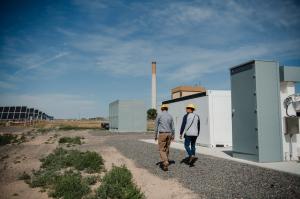How Dispatchable Resources Enable the Clean Energy Transition
In 2018, Platte River’s Board of Directors directed the CEO to work toward shifting to a more diverse portfolio powered by clean, renewable resources.
LOVELAND, CO, USA, April 29, 2024 /EINPresswire.com/ -- Since 1973, Platte River Power Authority has served the growing energy needs of families and businesses in Estes Park, Fort Collins, Longmont and Loveland. This energy comes from a generation portfolio largely made up of hydropower, coal and natural gas. In 2018, Platte River’s Board of Directors passed a Resource Diversification Policy (RDP) directing the CEO to work toward shifting to a more diverse portfolio powered by clean, renewable resources while maintaining reliability and financial sustainability.
“We are committed to meeting our RDP goals by creating a more diversified, low-carbon energy portfolio,” shares Jason Frisbie, CEO of Platte River. “Shifting from a traditional power supply with exceptional reliability to weather-dependent resources presents new challenges that we must overcome to continue reliably serving our owner communities.”
Platte River must prepare for the retirement of 431 megawatts (MW) of dispatchable, coal-fired generation by the end of the decade and address more frequent extreme weather events that can bring dark calms (periods when there is no sun or wind). As part of its resource planning process, Platte River is modeling different generation portfolios that will accelerate renewable integration with support from highly flexible, dispatchable capacity through a three-pronged approach: energy storage, a virtual power plant and aeroderivative technology. These will firm intermittent renewable resources and help us manage dark calms while providing regional market balancing services.
First, short-duration battery systems, like the one Platte River has at its Rawhide Energy Station, can harness and dispatch power during off-peak times for two to four hours. Plans are already underway to install 20-25 MW of four-hour battery storage in all four owner communities. Long-duration battery systems can discharge from 10 to 100 hours, depending on the technology. Platte River will pilot up to 10 MW of long-duration storage between now and 2028.
Second, Platte River is developing a framework across the owner communities to aggregate customers’ distributed energy resources (DER), like rooftop solar and smart thermostats. This effort will inform Platte River on how and when customers use their energy, and how the utilities’ collective resources can respond to these behaviors, through a virtual power plant.
Finally, Platte River will invest in aeroderivative turbines that run on natural gas but can transition to green hydrogen (a noncarbon-emitting fuel source), preserving our ability to advance toward a 100% noncarbon energy future.
While these efforts help Platte River get close to achieving the RDP goals, customers in the owner communities are essential to helping the region achieve its energy transition.
“Distribution-level resources are vital to maintaining system reliability as supply and demand change more quickly and less predictably,” says Kevin Gertig, Platte River Board Chair and Director for Loveland Water and Power. “It is imperative we work together with Platte River to build DERs throughout our communities to benefit the whole system.”
To learn more about Platte River’s commitment to a clean energy future, visit prpa.org/future.
Platte River Power Authority
2000 East Horsetooth Road, Fort Collins
www.prpa.org
(970) 226-4000
Kathleen West
Platte River Power Authority
+1 (970) 229.5267
email us here
Legal Disclaimer:
EIN Presswire provides this news content "as is" without warranty of any kind. We do not accept any responsibility or liability for the accuracy, content, images, videos, licenses, completeness, legality, or reliability of the information contained in this article. If you have any complaints or copyright issues related to this article, kindly contact the author above.


